
Monday, May 15, 2006
Tuesday, May 09, 2006
Big Sur
The people...
 |  |  |
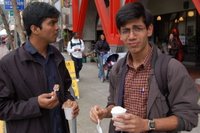 |  |
the places...
 |  |  |
 |  | 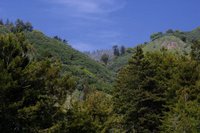 |
 |  |  |
and the end...
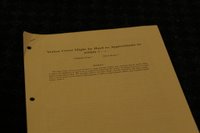 |
Friday, April 28, 2006
आग की भीख
A friend, Sushobhan Avasthi, first showed me this poem about four years ago. Since then I have read this one may times and many others by Dinkar too. Talking about his style, a friend once commented - "It seems he even thinks in musical way!" Indeed, most of Dinkar's poetry has a strong musical quality to it. Another quality which contributes to the "flow" is a very clear-cut division of ideas into small "units" which somehow feel like beads on a string. This is best illustrated by contrasting the following excerpts from Dinkar and Dharmveer Bharti -
और अकुलाती है,
मगर उसकी जड़ें धरती में
बेतरह गड़ी हुईं हैं।
इसलिए हवा के साथ
वह उड़ नहीं पाती है।
- दिनकर (कुंजी)
...... क्योंकि सपना है अभी भी -
इसलिए तलवार टूटे, अश्व घायल
कोहरे डूबी दिशायें,
कौन दुश्मन, कौन अपने लोग, सब कुछ धुंध-धूमिल,
किन्तु कायम युद्ध का संकल्प है अपना अभी भी
...... क्योंकि है सपना अभी भी!
- धर्मवीर भारती (क्योंकि)
आग की भीख
धुँधली हुई दिशाएँ, छाने लगा कुहासा,
कुचली हुई शिखा से आने लगा धुआँसा।
कोई मुझे बता दे, क्या आज हो रहा है,
मुंह को छिपा तिमिर में क्यों तेज सो रहा है?
दाता पुकार मेरी, संदीप्ति को जिला दे,
बुझती हुई शिखा को संजीवनी पिला दे।
प्यारे स्वदेश के हित अँगार माँगता हूँ।
चढ़ती जवानियों का श्रृंगार मांगता हूँ।
बेचैन हैं हवाएँ, सब ओर बेकली है,
कोई नहीं बताता, किश्ती किधर चली है?
मँझदार है, भँवर है या पास है किनारा?
यह नाश आ रहा है या सौभाग्य का सितारा?
आकाश पर अनल से लिख दे अदृष्ट मेरा,
भगवान, इस तरी को भरमा न दे अँधेरा।
तमवेधिनी किरण का संधान माँगता हूँ।
ध्रुव की कठिन घड़ी में, पहचान माँगता हूँ।
आगे पहाड़ को पा धारा रुकी हुई है,
बलपुंज केसरी की ग्रीवा झुकी हुई है,
अग्निस्फुलिंग रज का, बुझ डेर हो रहा है,
है रो रही जवानी, अँधेर हो रहा है!
निर्वाक है हिमालय, गंगा डरी हुई है,
निस्तब्धता निशा की दिन में भरी हुई है।
पंचास्यनाद भीषण, विकराल माँगता हूँ।
जड़ताविनाश को फिर भूचाल माँगता हूँ।
मन की बंधी उमंगें असहाय जल रही है,
अरमानआरज़ू की लाशें निकल रही हैं।
भीगीखुशी पलों में रातें गुज़ारते हैं,
सोती वसुन्धरा जब तुझको पुकारते हैं,
इनके लिये कहीं से निर्भीक तेज ला दे,
पिघले हुए अनल का इनको अमृत पिला दे।
उन्माद, बेकली का उत्थान माँगता हूँ।
विस्फोट माँगता हूँ, तूफान माँगता हूँ।
आँसूभरे दृगों में चिनगारियाँ सजा दे,
मेरे शमशान में आ श्रंगी जरा बजा दे।
फिर एक तीर सीनों के आरपार कर दे,
हिमशीत प्राण में फिर अंगार स्वच्छ भर दे।
आमर्ष को जगाने वाली शिखा नयी दे,
अनुभूतियाँ हृदय में दाता, अनलमयी दे।
विष का सदा लहू में संचार माँगता हूँ।
बेचैन ज़िन्दगी का मैं प्यार माँगता हूँ।
ठहरी हुई तरी को ठोकर लगा चला दे,
जो राह हो हमारी उसपर दिया जला दे।
गति में प्रभंजनों का आवेग फिर सबल दे,
इस जाँच की घड़ी में निष्ठा कड़ी, अचल दे।
हम दे चुके लहु हैं, तू देवता विभा दे,
अपने अनलविशिख से आकाश जगमगा दे।
प्यारे स्वदेश के हित वरदान माँगता हूँ।
तेरी दया विपद् में भगवान माँगता हूँ।
- दिनकर
Saturday, April 22, 2006
G-Drive
बेवजह देखता तू आसमॉं को क्यों खड़ा है?
सुबह हो जाए कल शायद, पर अॅंधेरा भी क्या बुरा है!
दिये मैं लौ अगर है बाकी तो अभी रात कहॉ,
जो मज़ा चलने में है, रुक जाने में वो बात कहॉं!
Sunday, April 09, 2006
Holi hai!!
Feeling the effects of old age in grad life, devoid of company (I wish more C-BOT people were here) but still curious, I dragged my poor room-mate along to at least watch the event and take a few pictures. Though we didn't actually play, I managed a few snaps as people posed quite readily. My first attempt at photographing strangers was not so disastrous! :-)
Holi was being played with loud Hindi music and almost an equal amount of color and water as in India (i.e. if you did use color to play). Fooled around, clicked random shots and finally met with an interesting chap (last photo) who explained to us some connections between the Indian and Greek mythologies. Finally back home to a cup of homemade espresso - Mmm..!
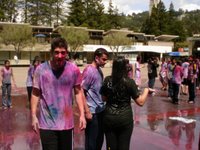 |  |
 | 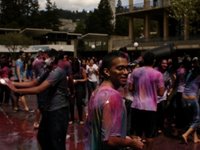 |
 | 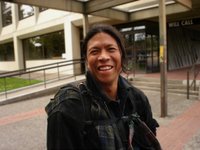 |
Thursday, March 30, 2006
Fermat's Enigma

The book itself is quite well written (one of the very few books I managed to almost finish in one sitting) and gives some interesting accounts of what went into the proof. It also tells stories about ancient Greek mathematics, few 17th and 18th century mathematicians and of course Andrew Wiles and his contemporaries. All this is intended for non-mathematical audience though. If you want to look at look at the mathematics Fermat's Last Theorem developed (i.e. the wrong proofs developed) read Paulo Ribenboim's "Fermat's Last Theorem for amateurs" or this link which also includes some ingredients of Wiles' proof.
It is interesting to realize the kind of gamble Wiles played. He set about proving the theorem in 1986 when it was realized that FLT would be implied by the Taniyama-Shimura conjecture (this was proved in Berkeley :-)). For the next seven years he worked in the attic of his home working with different techniques to prove the conjecture and announced a proof at Cambridge in 1993. It was later found to have a flaw which he corrected in 1994. Devoting a large part of his professional life to a single problem and working in secret all the time does require not only tenacity but also an amazing amount of self-confidence.
I wonder why although we say Indians are good mathematically, we hardly see examples of any great mathematics being done in India (ok - with the exception of the Primality testing algorithm). Is our education system geared towards a large number of "reasonably good" people rather than a few really good ones? Or are we afraid of the risks in focussing on one single thing and want to go for the low-hanging fruit? Ok.. enough of blabbering - go read the book!
Monday, March 27, 2006
आराम करो
एक मित्र मिले, बोले, "लाला, तुम किस चक्की का खाते हो?
इस डेढ़ छँटाक के राशन में भी तोंद बढ़ाए जाते हो।
क्या रक्खा है माँस बढ़ाने में, मनहूस, अक्ल से काम करो।
संक्रान्ति-काल की बेला है, मर मिटो, जगत में नाम करो।"
हम बोले, "रहने दो लेक्चर, पुरुषों को मत बदनाम करो।
इस दौड़-धूप में क्या रक्खा, आराम करो, आराम करो।
आराम ज़िन्दगी की कुंजी, इससे न तपेदिक होती है।
आराम सुधा की एक बूंद, तन का दुबलापन खोती है।
आराम शब्द में 'राम' छिपा जो भव-बंधन को खोता है।
आराम शब्द का ज्ञाता तो विरला ही योगी होता है।
इसलिए तुम्हें समझाता हूँ, मेरे अनुभव से काम करो।
ये जीवन, यौवन क्षणभंगुर, आराम करो, आराम करो।
यदि करना ही कुछ पड़ जाए तो अधिक न तुम उत्पात करो।
अपने घर में बैठे-बैठे बस लंबी-लंबी बात करो।
करने-धरने में क्या रक्खा जो रक्खा बात बनाने में।
जो ओठ हिलाने में रस है, वह कभी न हाथ हिलाने में।
तुम मुझसे पूछो बतलाऊँ -- है मज़ा मूर्ख कहलाने में।
जीवन-जागृति में क्या रक्खा जो रक्खा है सो जाने में।
मैं यही सोचकर पास अक्ल के, कम ही जाया करता हूँ।
जो बुद्धिमान जन होते हैं, उनसे कतराया करता हूँ।
दीए जलने के पहले ही घर में आ जाया करता हूँ।
जो मिलता है, खा लेता हूँ, चुपके सो जाया करता हूँ।
मेरी गीता में लिखा हुआ -- सच्चे योगी जो होते हैं,
वे कम-से-कम बारह घंटे तो बेफ़िक्री से सोते हैं।
अदवायन खिंची खाट में जो पड़ते ही आनंद आता है।
वह सात स्वर्ग, अपवर्ग, मोक्ष से भी ऊँचा उठ जाता है।
जब 'सुख की नींद' कढ़ा तकिया, इस सर के नीचे आता है,
तो सच कहता हूँ इस सर में, इंजन जैसा लग जाता है।
मैं मेल ट्रेन हो जाता हूँ, बुद्धि भी फक-फक करती है।
भावों का रश हो जाता है, कविता सब उमड़ी पड़ती है।
मैं औरों की तो नहीं, बात पहले अपनी ही लेता हूँ।
मैं पड़ा खाट पर बूटों को ऊँटों की उपमा देता हूँ।
मैं खटरागी हूँ मुझको तो खटिया में गीत फूटते हैं।
छत की कड़ियाँ गिनते-गिनते छंदों के बंध टूटते हैं।
मैं इसीलिए तो कहता हूँ मेरे अनुभव से काम करो।
यह खाट बिछा लो आँगन में, लेटो, बैठो, आराम करो।
- गोपालप्रसाद व्यास